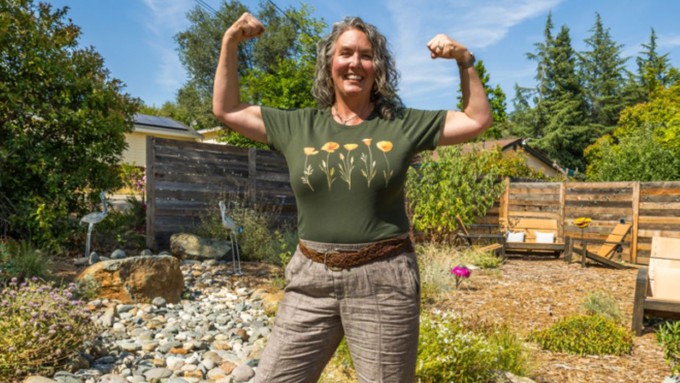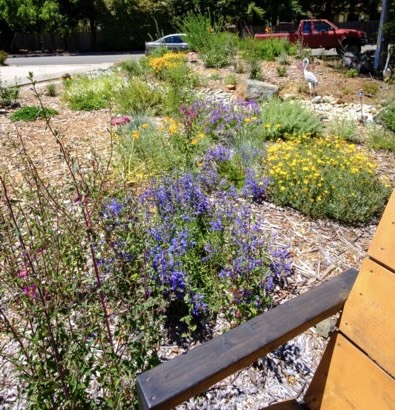
After oak falls on her house, Auburn teacher turns once-shady space into pollinator paradise

Christina Bickley of Auburn was one of six "Summer Strong Yard" winners in the Regional Water Authority contest this year. Courtesy BeWaterSmart.info
The transformation of Christina Bickley’s Auburn frontyard started with a boom – literally.
“We ripped out our lawn after our oak tree fell on our house,” she says. “So much sunshine, so we decided to go native to reduce water use and support native pollinators.”
Bickley teaches 7th- and 8th-grade science and STEAM (Science, Technology, Engineering, the Arts and Mathematics); she’s familiar with botany. She knew her oak tree was in decline, but its sudden collapse was a shock.
“It was a beautiful tree,” she recalls. “It was near the middle of the lawn. All that lawn – and all that watering – made it susceptible. It was a very vigorous lawn, and the tree got unhealthier and unhealthier.”
A wind storm in 2019 was enough to push it over.
“When it fell, it clipped the front part of the house; the garage and the cars took most of the impact,” Bickley says. “We discovered the oak was infested with ants that had hollowed it out. Without the tree, it made it quite sunny. It was a drastic change."

And an opportunity; it was time for a makeover.
“That definitely got us started,” she says. “It was during the drought; we didn’t want to water anything that wasn’t food.”
For her efforts and her garden’s transformation, Bickley was named a “Summer Strong Yard” winner by the Regional Water Authority. Her garden was featured in an ongoing campaign to inspire other residents to tackle their own water-wise makeovers.
While rethinking her yard, Bickley also became interested in pollinator-friendly native plants and helping wildlife. “My longtime goal is to support bees.”
After the demise of the tree, she suddenly had plenty of sun – a must for tomatoes and most native plants. “Losing the tree tipped the scale,” she says.
Bickley sheet-mulched the lawn with cardboard and wood chips -- a slow process that allows the turf to decompose in place. She installed drip irrigation and did lots of research on native plants.
“We did it all ourselves; it took a year,” she says. “The biggest investment was an earth mover and a big dumpster.”
As for going native, Bickley recommends Calscape.org (an online resource from the California Native Plant Society) and the “Gardens Gone Native” garden tour, hosted by the Sacramento Valley chapter of CNPS. “That tour was a real eye opener; all the different colors and combinations.”
Her new favorites? “I’m just in love with Matilija poppies, the fried egg plant. I also love coyote mint, elegant clarkia, California buckwheat, woolly sunflowers, a ton of sage. The self-seeded poppies are fabulous. I plan to have something blooming year round.”
Bickley is now tackling the rest of her landscape. She’s looking into rebates from her water provider, Placer County Water Agency. “It’s nice to have incentives out there.”
Comments
0 comments have been posted.Sacramento Digs Gardening to your inbox.
Food in My Back Yard Series
May 6: Maintain soil moisture with mulch for garden success
April 29: What's (already) wrong with my tomato plants?
April 22: Should you stock up on fertilizer? (Yes!)
April 15: Grow culinary herbs in containers
April 8: When to plant summer vegetables
April 1: Don't be fooled by these garden myths
March 25: Fertilizer tips: How to 'feed' your vegetables for healthy growth
March 18: Time to give vegetable seedlings some more space
March 11: Ways to win the fight against weeds
March 4: Potatoes from the garden
Feb. 25: Plant a fruit tree now -- for later
Feb. 18: How to squeeze more food into less space
Feb. 11: When to plant? Consider staggering your transplants
Feb. 4: Starting in seed starting
Sites We Like
Garden Checklist for week of May 11
Make the most of the lower temperatures early in the week. We’ll be back in the 80s by Thursday.
* Plant, plant, plant! It’s prime planting season in the Sacramento area. Time to set out those tomato transplants along with peppers and eggplants. Pinch off any flowers on new transplants to make them concentrate on establishing roots instead of setting premature fruit.
* Direct-seed melons, cucumbers, summer squash, corn, radishes, pumpkins and annual herbs such as basil.
* Harvest cabbage, lettuce, peas and green onions.
* In the flower garden, direct-seed sunflowers, cosmos, salvia, zinnias, marigolds, celosia and asters. (You also can transplant seedlings for many of the same flowers.)
* Plant dahlia tubers.
* Transplant petunias, marigolds and perennial flowers such as astilbe, columbine, coneflowers, coreopsis, dahlias, rudbeckia and verbena.
* Keep an eye out for slugs, snails, earwigs and aphids that want to dine on tender new growth.
* Feed summer bloomers with a balanced fertilizer.
* For continued bloom, cut off spent flowers on roses as well as other flowering plants.
* Add mulch to the garden to maintain moisture. Mulch also cuts down on weeds. But don’t let it mound around the stems or trunks of trees or shrubs. Leave about a 6-inch-to-1-foot circle to avoid crown rot or other problems.
* Remember to weed! Pull those nasties before they set seed.
* Water early in the day and keep seedlings evenly moist.